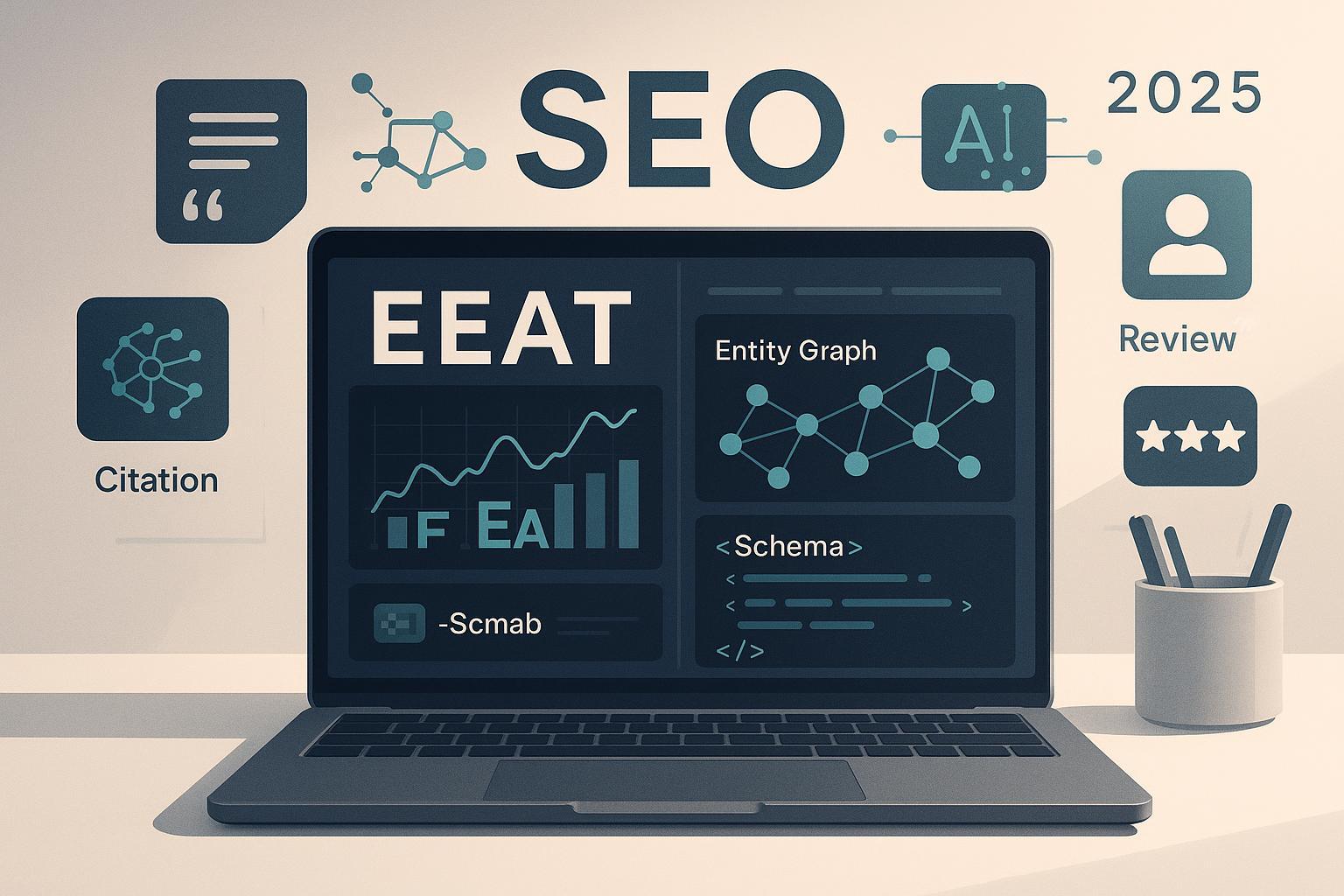11 Best AI SEO Tools to Build Real E‑E‑A‑T in 2025

If you’re trying to prove Experience, Expertise, Authoritativeness, and Trustworthiness (E‑E‑A‑T) at scale, AI can help you operationalize the work: plan topical clusters, add structure, cite sources, and monitor how your brand shows up across AI search. Google’s own guidance emphasizes people‑first content and technical cleanliness, which are foundational to trust signals, as outlined in the Google SEO Starter Guide. Industry coverage in 2025 continues to stress demonstrating first‑hand experience, subject‑matter expertise, and clear sourcing, as summarized in Search Engine Land’s guide to Google E‑E‑A‑T for SEO (2025).
Selection criteria: Every tool below (a) supports one or more E‑E‑A‑T signals in a verifiable way, (b) is relevant in 2025, and (c) fits into practical workflows. Where helpful, I include mini‑workflows and caveats.
—
1) Semrush
What it is: A comprehensive SEO platform that pairs research with AI‑assisted content tools and visibility tracking.
How this supports E‑E‑A‑T
- Expertise/Authoritativeness: Topic research, briefs, and optimization help you cover subjects deeply and align with search intent.
- Trust: Track how your pages surface in new SERP formats; fix technical issues that undermine credibility.
Practical workflow
- Plan clusters with Keyword Magic Tool, build briefs/drafts in the content toolkit, then audit and track. Semrush documents how to research and analyze AI Overviews within its toolset in its AI Overview knowledge base (2024–2025). For optimization patterns, see Semrush’s 2025 guidance on AI Overviews research and optimization.
Caveats
- Don’t expect direct control over AI answers; use the data to inform content quality and coverage.
—
2) Yext
What it is: A digital experience platform with an underlying Knowledge Graph to manage entities, reviews, and schema‑rich pages.
How this supports E‑E‑A‑T
- Authoritativeness/Trust: Centralized entity data and structured content clarify who you are (organization, authors) and why you’re credible; integrated reviews offer social proof.
Practical workflow
- Model authors, products, and locations in the Knowledge Graph; ship schema‑enhanced pages; centralize reviews. See Yext’s docs on Knowledge Graph entities and Review Management API. For how pages translate content for AI/search, Yext explains schema use in its overview of Pages and AI experiences (2024).
Caveats
- Requires data governance and implementation time; results improve with consistent, accurate inputs.
—
3) MarketMuse
What it is: An AI content strategy platform for topic modeling, content briefs, and gap analysis.
How this supports E‑E‑A‑T
- Expertise: Ensures comprehensive topical coverage and reduces thin content.
- Authoritativeness: Identifies gaps across a cluster to strengthen your footprint.
Practical workflow
- Audit a cluster and generate briefs to guide writers. MarketMuse details its approach to briefs and clustering in its pages on why MarketMuse and topic clusters.
Caveats
- Strong for planning and briefs; pair with editorial standards that require first‑hand experience and citations.
—
4) WordLift
What it is: An AI + knowledge graph platform that automates schema markup, entity modeling, and semantic SEO.
How this supports E‑E‑A‑T
- Authoritativeness/Trust: Structured data clarifies authorship, claims, and relationships; fact‑checking workflows support accuracy.
Practical workflow
- Build your site knowledge graph and automate schema for Articles, FAQs, and more. Explore WordLift’s case study on legal services performance impact in its knowledge graph and schema automation overview, and its article on AI‑assisted fact checking (2024–2025).
Caveats
- Automations benefit from human QA; incorrect entity mapping can mislead search engines.
—
5) Alli AI
What it is: An AI SEO automation platform for on‑page changes and JSON‑LD schema generation.
How this supports E‑E‑A‑T
- Trust/Authoritativeness: Clear, consistent metadata and structured data (e.g., Product/Review) help machines interpret trust signals.
Practical workflow
- Bulk‑improve titles/descriptions and generate schema, then review for accuracy before deploying. See the feature pages for AI SEO automation and the AI Schema Markup Generator.
Caveats
- Over‑automation can introduce errors; validate schema aligns with real on‑page content and policies.
—
6) ZipTie.dev
What it is: Monitoring for brand visibility, citations, and sentiment across AI answer engines (Google AI Overviews, ChatGPT, Perplexity).
How this supports E‑E‑A‑T
- Authoritativeness/Trust: See when and how you’re cited in AI answers; plug content gaps to earn better citations.
Practical workflow
- Track priority queries and monitor AI Overviews and answer engine outputs. ZipTie shares methodology and dashboards in its posts on tracking AI Overviews, ChatGPT, and Perplexity (2025) and the live AI Overviews monitor.
Caveats
- Treat vendor‑reported detection metrics with healthy skepticism; triangulate with your own tests.
—
7) ChatGPT Plus or Team
What it is: OpenAI’s conversational AI with browsing, custom GPTs, and Advanced Data Analysis for research and editorial ops.
How this supports E‑E‑A‑T
- Trust: Browsing can surface source‑backed claims; enforce citation rules in prompts.
- Expertise/Experience: Codify house style and SME inputs via custom GPTs; analyze datasets with ADA.
Practical workflow
- Create a custom GPT with your editorial checklist (citations required, SME review). Use browsing to compile sources and ADA to analyze exports. See OpenAI’s ChatGPT release notes (updated through 2025) and the announcement of GPT‑4o access for ChatGPT.
Caveats
- Always verify citations; browsing behavior and output formats evolve.
—
8) Perplexity
What it is: An AI research assistant that emphasizes citations and enterprise knowledge features.
How this supports E‑E‑A‑T
- Trust/Authoritativeness: Transparent citations; enterprise plans integrate internal knowledge securely.
Practical workflow
- Build a curated Space of authoritative sources, then outline and export citations. Learn about Spaces/Internal Knowledge in Perplexity’s post on introducing Internal Knowledge Search and Spaces (2025) and its case study with Inteleos (2025).
Caveats
- Still requires human source evaluation; avoid over‑reliance on summarized claims.
—
9) Clearscope
What it is: A content optimization platform with AI outlines, topical coverage suggestions, and readability grading.
How this supports E‑E‑A‑T
- Expertise: Guides comprehensive coverage and entity usage.
- Trust: Improves clarity and formatting readers expect from professional content.
Practical workflow
- Generate an AI outline and optimize to a target grade. See Clearscope’s May 2024 product updates introducing AI outlines and guidance on measuring topical authority.
Caveats
- Don’t chase grades blindly; incorporate first‑hand insights and credible sources.
—
10) Originality.ai
What it is: AI‑content and plagiarism detection with audit trails for editorial governance.
How this supports E‑E‑A‑T
- Trust: Helps you ensure originality, reduce plagiarism risk, and maintain transparent authorship logs.
Practical workflow
- Scan drafts, review flags, verify facts, and store audit reports. See the platform’s overview of its AI checker and governance use cases (2025) and guidance on choosing a fact checker.
Caveats
- Use as a signal, not a verdict; combine with human editorial review.
—
11) Nightwatch
What it is: Rank tracking with SERP feature monitoring, including evolving coverage for AI Overviews.
How this supports E‑E‑A‑T
- Authoritativeness/Trust: Track how often your brand earns featured snippets, PAA, and AI Overview presence—surfaces that signal authority.
Practical workflow
- Add keywords, enable SERP feature columns, and set alerts. Nightwatch explains AI Overviews coverage and SERP data in its articles on AI Overviews tracking (2025) and SERP data methodology.
Caveats
- Treat AI Overview metrics as directional; triangulate with other sources and manual checks.
—
Bonus: QuickCreator (Your AI Content Production & Optimization Platform)
What it is: An AI‑powered blogging platform with real‑time SERP/topic recommendations, an intuitive block‑based editor, team collaboration, analytics, free hosting, and one‑click WordPress publishing.
How this supports E‑E‑A‑T
- Experience: Easily add first‑hand evidence blocks (photos, videos, methodology) and maintain consistent author bios.
- Expertise/Authoritativeness: Plan topical clusters with SERP/topic recommendations; collaborate with SMEs; track performance to refine.
Practical workflow
- Plan a cluster from SERP recommendations, draft with integrated AI, embed multimedia proof, add author bylines and credentials, then publish to WordPress or host on QuickCreator. Explore recent articles on the QuickCreator site that showcase these workflows, like its roundup of the best free blog sites for beginners in 2025.
Caveats
- QuickCreator focuses on production and optimization; pair with schema/reputation tools when you need advanced entity and review features.
—
Stack recipes (pick what matches your team and budget)
-
Solo creator on a budget
- Planning/coverage: MarketMuse or Clearscope (lite usage)
- Drafting/research: ChatGPT Plus + Perplexity for citation‑backed outlines
- Production: QuickCreator for bylines, evidence blocks, and publishing
- Monitoring: Nightwatch (starter) or manual checks; ZipTie.dev for AI answer engine visibility on a few key terms
-
SMB marketing team
- Strategy and monitoring: Semrush for clusters, audits, and tracking
- Content ops: QuickCreator for collaboration + multimedia; Clearscope for optimization
- Entity/schema: WordLift or Alli AI (with human QA)
- Reputation/AI visibility: Yext for reviews + entities; ZipTie.dev for AI Overviews/answer engines
-
Agency stack
- Research and planning: MarketMuse + Semrush
- Production at scale: QuickCreator for multi‑language and team workflows
- Structure and entities: WordLift across clients; Alli AI for deployment at scale (with QA)
- Governance and monitoring: Originality.ai for audits; Nightwatch + ZipTie.dev for SERP and AI surfaces; Yext where reviews/locations matter
—
Quick buyer’s guide (which tool for which E‑E‑A‑T job?)
- Planning topical authority: MarketMuse, Semrush, Clearscope
- Proving authorship and entities: WordLift, Yext
- Adding structure (schema): WordLift, Alli AI
- Drafting with sources: Perplexity, ChatGPT Plus/Team
- Demonstrating first‑hand experience: QuickCreator (multimedia + methodology blocks)
- Monitoring authority signals: Nightwatch (SERP features), ZipTie.dev (AI answer engines)
- Editorial governance and trust: Originality.ai
—
E‑E‑A‑T workflow checklist you can run every month
- Plan: Refresh your cluster map and briefs (MarketMuse/Semrush)
- Produce: Draft with citations; embed evidence and bylines (Perplexity/ChatGPT + QuickCreator)
- Structure: Validate schema and entities (WordLift/Alli AI; Yext for org/authors/reviews)
- Publish: Ship with clean metadata and technical checks (Semrush + QuickCreator)
- Monitor: Track SERP features and AI answers (Nightwatch + ZipTie.dev)
- Govern: Run originality/plagiarism checks; maintain author pages and review responses (Originality.ai + Yext)
—
FAQs
-
Do AI tools “increase E‑E‑A‑T” automatically?
- No. Tools help you demonstrate real expertise and trust signals, but you still need first‑hand experience, credible sources, and human editorial review. See the Google SEO Starter Guide for quality fundamentals.
-
Should I optimize specifically for AI Overviews?
- Treat AI Overviews as another visibility surface. Semrush’s guides on researching and optimizing for AI Overviews are helpful, but resist shortcuts—focus on depth, clarity, and evidence.
-
Is schema required to demonstrate E‑E‑A‑T?
- Schema clarifies entities and can bolster trust surfaces (authors, reviews, products). Platforms like WordLift’s schema automation and Alli AI’s schema generator help, but accuracy and honesty matter more than markup volume.
-
How do I show first‑hand experience in content?
- Add a methodology section, photos/videos of your process, and author credentials. A production platform like QuickCreator’s AI blogging workflow makes this easier with blocks and multimedia embedding.
—
Bottom line: Building E‑E‑A‑T in 2025 is about making your real expertise legible to people and machines. Use AI tools to plan, structure, evidence, and monitor—but keep humans in the loop to ensure accuracy and integrity.

